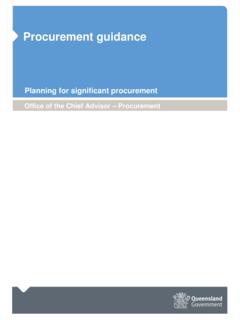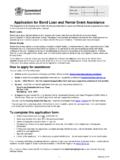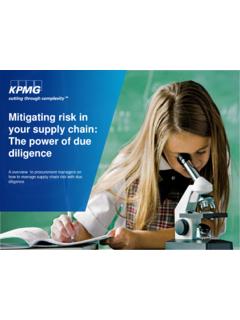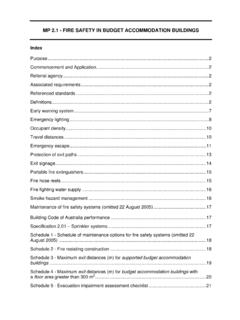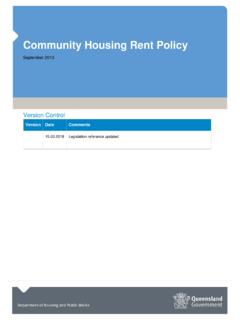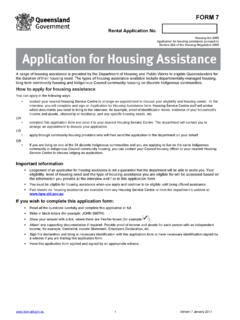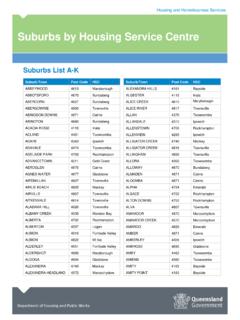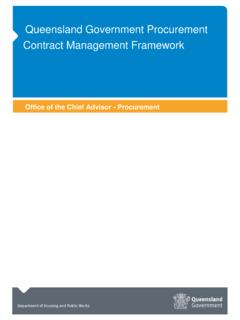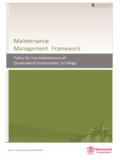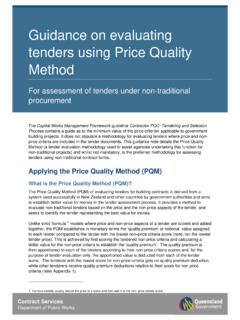Transcription of QFleet Fleet Efficiency and Utilisation Policy
1 QFleet Utilisation Standard for the Queensland Government motor vehicle Fleet ContentsIntroduction 1 Overview of the QFleet Utilisation Standard 2 Purpose of the Standard 3 Scope of the Standard 3 Accountability for Fleet management 3 Step 1: Recognise the Fleet as a valuable asset Effective Fleet use Principles of effective Fleet use 4 Step 2: Conduct a strategic Fleet management review Purpose of the review Forward planning 5 Table 1: Strategic Fleet management review matrix 6 Step 3: Ensure agency Fleet Policy and processes align with government Policy and Fleet best-practice Best-practice Utilisation 7 Managing demand and consumption 7 Agency Whole-of- Fleet Performance Guideline Environment and climate change 8 Is a government vehicle the best choice? 8 Other ways to enhance environmental outcomes Carpooling and QFleet Car Share 9 Carpooling 9 QFleet Car Share 9 Vehicle allocation 9 Table 2: Indicative vehicle-to-task allocation matrix Procurement and value-for-money 11 Queensland Procurement Policy 11 Economic objectives 11 Environmental objectives 11 Social objectives 11 Step 4: Assess the Fleet using the Agency Whole-of- Fleet Performance Guideline Applying the Agency Whole-of- Fleet Performance Guideline 12 Agency carpool vehicles 13 Table 3: Agency Whole-of- Fleet Performance Guideline: Performance Utilisation range 14 Performance Utilisation Range Categories Utilisation technology 16 Step 5.
2 Make informed decisions about replacement and additional vehicles Justify each vehicle Create the new lease Selecting the vehicle 17 Customer assistance and advice 17 Roles and responsibilities under the Standard 18 QFleet 18 Queensland Government agencies 18 Fleet Utilisation Standard Summary 19 Glossary of terms 20 Referenced documents 21 IntroductionThis document the QFleet Utilisation Standard for the Queensland Government motor vehicle Fleet (the Standard) informs the strategic and operational management of Queensland s Fleet of government vehicles. It is a companion document to: the QFleet Environmental Strategy for the Queensland Government motor vehicle Fleet 1 the QFleet Electric Vehicle Strategy for the Queensland Government motor vehicle Fleet 2 the QFleet Emissions Reduction Guide for the Queensland Government motor vehicle The Standard replaces the QFleet Fleet Efficiency and Utilisation Policy for the Queensland Government motor vehicle Fleet (published in 2010).
3 The Queensland Government Fleet is complex, dynamic and valuable. Its vehicles are used by government agencies to deliver services to the people of Queensland. The Fleet s composition and operation are influenced by safety, cost, operational need and environmental impact. The Standard provides an easy to follow, five-step model to support agencies Fleet management. By using the Standard, agencies can make informed decisions about the size and composition of their fleets to optimise Efficiency and whole-of-government Standard encourages regular, thorough, agency-level Fleet reviews to assist in preparing robust replacement decisions. Agencies should review their vehicle requirements at least once a year and assess their requirements using the Agency Whole-of- Fleet Performance Guideline (Step 4). This may reveal opportunities to rotate or redeploy vehicles to better manage vehicle Utilisation . It will also help agencies to evaluate the need for vehicles and consider opportunities to reduce their Fleet Standard supports agencies to meet government and community expectations for accountability, transparency and Standard is relevant for all staff involved in the management of their agency s vehicles.
4 Agencies that acquire and manage their own vehicles are encouraged to apply the Standard principles to their Fleet Utilisation and replacement Utilisation STANDARD 1 Overview of the QFleet Utilisation StandardThe Standard is designed to support the efficient Utilisation of each vehicle in the Queensland Government Fleet in a way that contributes to overall productivity and cost effectiveness. Effective Fleet Utilisation starts with fit-for-purpose vehicle selection, supported by lease parameters based on realistic estimates of the annual distance (kilometres) to be travelled. It involves regular monitoring against lease parameters, with adjustments made if necessary. Effective Fleet Utilisation results in the return of the vehicle at the end of the specified lease duration (months) having achieved within 90 per cent of the specified lease Fleet Utilisation helps to ensure a stable Fleet replacement program and avoids additional costs related to excess kilometres, early lease termination or lease Standard promotes continuous improvement and Fleet management best-practice.
5 It outlines five steps in effective Fleet Utilisation :Step 1 Recognise the Fleet as a valuable assetStep 2 Conduct a strategic Fleet -management reviewStep 3 Ensure agency Fleet Policy and processes align with government Policy and Fleet best-practiceStep 4 Assess the Fleet using the Agency Whole-of- Fleet Performance GuidelineStep 5 Make informed decisions about replacement and additional vehiclesQFLEET Utilisation STANDARD 2 Efficient vehicle Utilisation delivers value for the government s multi-million dollar investment in the of the StandardThe Standard guides the effective Utilisation of the government Fleet for the benefit of the government, its agencies and the communities they is designed to be consistent with government priorities and to integrate with agency functions and application should enhance Fleet management at both agency and whole-of-government of the StandardThe Standard provides the basis for agencies to make consistent and coordinated decisions that meet their vehicle and Fleet Utilisation obligations.
6 It applies to all levels of Fleet management, including individual vehicles and large implementation of the Standard requires support from CEOs, agency senior Fleet managers and those who supervise vehicle pooling and allocation. The Standard is primarily designed for use by government agencies and entities that lease vehicles through QFleet . However, agencies and entities that own and operate their own fleets are encouraged to adopt the principles of the may identify exempted vehicles which cannot conform to all aspects of the Standard due to their service delivery role, commercial contribution or special operational deployment (such as emergency response vehicles).Accountability for Fleet managementFleet management involves significant financial and performance aspects. This has implications for CEOs, who are responsible and accountable for managing their fleets in accordance with the Financial and Performance Management Standard are also responsible for certain matters that influence vehicle Utilisation , such as compliance with the Public Service Commission Policy Use of Government Owned Motor Vehicles and Parking of Private Vehicles on Official are responsible for the operational management of their management and accountability are supported by data collection and analysis.
7 Agencies must ensure that all journeys are suitably recorded through either hard-copy logbooks, QFleet s Betasphere system, Utilisation Management System (UMS), QFleet Car Share reporting or the agencies own electronic recording systems. Suitable recording is essential for effective Fleet management because it provides information about daily, monthly and seasonal vehicle use. It is also required by the Public Service Commission Policy and is necessary for FBT is responsible for the government s centralised arrangements for vehicle aggregation, financing, acquisition, ownership, in-service management, reporting and disposal. QFleet is also responsible for providing advice, reports and tools to assist agencies in optimising their Fleet Efficiency and Utilisation STANDARD 3 Step 1: Recognise the Fleet as a valuable Effective Fleet use The Queensland Government vehicle Fleet is a valuable resource, essential to the daily work of government agencies right across the state.
8 The vehicle Fleet must be used efficiently and Fleet use that avoids vehicle over-and under- Utilisation prevents avoidable cost. Effective Fleet management and Fleet use delivers value for the government s multi-million-dollar investment in the Principles of effective Fleet useEffective Fleet use is influenced by: service delivery to Fleet users Fleet size Fleet composition individual vehicle deployment and operation adherence to relevant government Standard is designed to support optimal use of the Fleet across Standard: encourages a Utilisation -management focus where agencies consider vehicle selection, deployment and operation proposes a Fleet -wide approach to Fleet composition and deployment promotes evidence-based decisions about lease parameters provides guidelines for the time and kilometre use of each vehicle recommends periodic review and adjustment to vehicle allocation and deployment encourages agencies to consider alternative transport methods and reduce use of government vehicles where appropriate encourages agencies to carpool to optimise Efficiency encourages agencies to use QFleet Car Share (where available) to expand transport solutions avoids the unnecessary leasing and use of government vehicles highlights the environmental impact of vehicle use and supports the Queensland Government s commitment to mitigate climate Utilisation STANDARD 4 Step 1: Recognise the Fleet as a valuable assetStep 2.
9 Conduct a strategic Fleet management reviewThe Standard is designed to help agencies conduct a rigorous, strategic review of their Fleet , and to use the review s outcomes for Fleet decision making. QFleet recommends that agencies should review their Fleet management at least annually, or more frequently if required. QFleet s client services team is available to support agencies in conducting their Purpose of the reviewA strategic Fleet management review is designed to: define the agency s Fleet requirements in the light of safety, financial and environmental factors evaluate the current performance and effectiveness of the Fleet according to the measures outlined in the Agency Whole-of- Fleet Performance Guideline (see Step ) consider whether the total operational distance of the Fleet can be reduced or delivered with fewer vehicles, based on the measures in the Agency Whole-of- Fleet Performance Guideline (see Step ). adjust Fleet management practices for vehicles that fall outside the optimum performance Utilisation range (see Table 3) consider and implement, where applicable, actions to manage the Fleet more efficiently and cost effectively, such as QFleet Car Share, carpooling, alternative transport choices, telecommuting and avoiding unnecessary home garaging (see Step 3) assess the Fleet s suitability to meet genuine, current and anticipated operational requirements, in terms of its size, composition and lease packages identify and eliminate avoidable Fleet Forward planningForward planning should be based on the strategic Fleet management review alongside a more detailed best-practice review (Step 3) and a performance review (Step 4).
10 Together, these reviews will provide insight into the short- and medium-term evolution of the agency s November, December and January each year, QFleet s client services team meets with agencies to prepare forward-commitment projections for the coming 12-months and outer years. These are based on the agencies strategic Fleet management reviews and influenced by decisions about vehicle replacement and additional vehicle needs (Step 5).Agencies forward-commitment projections are critical for QFleet s negotiations with vehicle manufacturers. The accuracy of forward planning directly influences vehicle procurement processes and can lead to substantial cost savings for government through volume preparation for the process, QFleet s customer services team produces a review matrix showing the key elements for each vehicle according to lease-end example of the matrix is shown in Table 1. A QFleet Fleet consultant works with the customer to plan the forward replacement program, considering fit-for-purpose requirements, safety, whole-of-life costs, value-for-money, and emissions.
